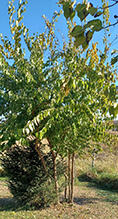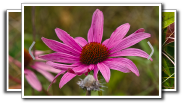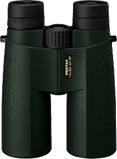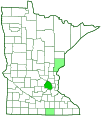Osage-orange
(Maclura pomifera)
Conservation • Weed • Wetland • Description • Habitat • Ecology • Use • Distribution • Taxonomy
Conservation Status |
|||
| IUCN Red List | LC - Least Concern |
||
| NatureServe | N4N5 - Apparently Secure to Secure |
||
| Minnesota | not listed |
||
Weed Status |
|||
Osage-orange is sometimes considered invasive. It can form a dense thicket in ephemeral streambeds (draws). It is listed as a nuisance species in Missouri. |
|||
Wetland Indicator Status |
|
||
| Great Plains | FACU - Facultative upland |
||
| Midwest | FACU - Facultative upland |
||
| Northcentral & Northeast | FACU - Facultative upland |
||
Description
Osage-orange is a small to medium sized deciduous tree that is native to the Red River drainage basin of southern Oklahoma, southern Arkansas, the Blackland Prairies and Post Oak Savannas of eastern Texas, and the Chisos Mountains of western Texas. It has been planted as a hedge in all the 48 contiguous states of the United States and in southeastern Canada. It is now naturalized in the eastern half of the U.S. except along the northern border, and it occurs in scattered populations throughout the west.
Osage-orange is found in bottomland and upland forests, in bottomland and upland prairies, on the banks of rivers and streams, at the margins of marshes and ponds, and in pastures, thickets, fencerows, and roadsides. It is hardy to zone 4, which includes central Minnesota, but trees that far north may not reach full size and may suffer some branch dieback in severe winters.
Osage-orange is fast growing and 26′ to 66′ (8 to 20 m) in height. It usually grows too fast to be considered a shrub unless it is aggressively pruned for that purpose. It grows under full or partial sun in moist to moderately dry conditions. It is highly tolerant and will grow in almost any soil that is not highly acidic. In fertile soil, the root system is deep, in shallow soil it is very widespread, and where planted it is variable.
The trunk is short and often crooked, the branches are arching upward to spreading, and the crown is broad and rounded or irregular.
The bark is brown to dark orangish brown. It is shallowly furrowed with flat ridges when young. Older bark has deep furrows, and the ridges often peel into long, thin strips.
The twigs are zigzag and relatively stout. First-year twigs are bright green to greenish yellow and minutely hairy at first, becoming orangish brown and hairless with age. They have circular to oval, light-colored, pore-like openings (lenticels). They are armed with stout, straight, ⅜″ to 1″ (1 to 2.5 cm) long thorns in most leaf axils, especially those facing the sun. They exude a milky sap when cut. Second-year twigs sometimes form short spur branches with two to four leaves. The leaf scars are half-round, and the bundle scars are arranged in an oval.
There is no terminal bud. Lateral buds are often paired. The larger of the two is pale reddish brown, 1⁄32″ to 1⁄16″ (1.5 to 2 mm) long, globe-shaped, and covered by several scales. The scales are reddish-brown and have a fringe of minute hairs.
The leaves are alternate, but on short branches they appear more or less whorled. The leaf stalks (petioles) are ⅜″ to 1″ (1 to 2.5 cm) long and covered with short hairs. At the base of each petiole there is a lance-shaped, 1⁄32″ to 1⁄16″ (1.5 to 2 mm) long, leaf-like appendage (stipule), but these are shed at an early stage. The leaf blades are egg-shaped to narrowly egg-shaped, 1½″ to 4¾″ (4 to 12 cm) long, ¾″ to 2⅜″ (2 to 6 cm) wide, rounded at the base, and sharply pointed at the tip with concave sides along the tip (acuminate). The upper surface is medium to dark green, glossy, and hairless. The lower surface is pale and almost hairless, but with hairs along the midrib and veins. The margins are not lobed or toothed (entire).
Male (staminate) and female (pistillate) inflorescences are found on separate trees (dioecious). One to three clusters of staminate flowers appear in the leaf axils of short branches. Each cluster hangs from a hairy, ⅜″ to ⅝″ (10 to 15 mm) long stalk (peduncle). The clusters are globe-shaped or cylindric and ½″ to ⅞″ (13 to 22 mm) long.
Staminate flowers are about ⅛″ (3 to 4 mm) wide. They have 4 outer floral leaves (sepals), 4 stamens, and no petals. The sepals (together the calyx) are yellowish green, fused at the base, and separated into four lobes. The lobes are hairy, about 1⁄32″ (1 mm) long, and pointed. The stamens are about 1⁄16″ (2 mm) long, the anthers are yellow, and the stalks (filaments) are flattened and closely appressed to the sepals.
The pistillate inflorescence is a single globe-shaped head rising from a leaf axil on a 1⁄16″ (2.0 to 2.5 mm) long stalk (peduncle). The head is ⅜″ to ⅝″ (10 to 15 mm) in diameter but it appears larger due to the long stigmas. Each head has up to 200 appressed flowers that are compressed tightly together. Each flower has 4 sepals (calyx) and 1 style. The sepals are green, egg-shaped, and about ⅛″ (3 mm) long. They are fused at the base and separated into four long lobes. The lobes are inversely egg-shaped and they are densely hairy at the tips. Together they form a hood closely appressed and completely covering the ovary. The style has two branches. The base is green and about ⅛″ (3 mm) long and the branches are ⅛″ to ¼″ (4 to 6 mm) long. The stigmas are yellowish and unbranched.
The fruit is a fleshy, spherical, aggregate mass, 3½″ to 5½″ (9 to 14 cm) in diameter at maturity. It looks somewhat similar to an orange, but it is not edible. It secretes a milky juice when crushed. It is composed of numerous seed capsules (achenes), each one enclosed in a thickened, enlarged calyx, all of them fused together and sunken into the greatly enlarged receptacle. The surface is yellowish green to green, intricately wrinkled, with numerous rounded, raised projections (tubercles). There are often scattered, short, remains of the stigmas.
Height
26′ to 66′ (8 to 20 m)
Flower Color
Male flowers yellowish green, female flowers green
Similar Species
Habitat
Bottomland and upland forests, bottomland and upland prairies, banks of rivers and streams, margins of marshes and ponds, pastures, thickets, fencerows, and roadsides.
Ecology
Flowering
May to June
Pests and Diseases
Use
Osage-orange was used by European settlers as a hedge plant. With aggressive pruning, its dense growth and strong thorns create a thorny hedge that is “pig tight, horse high, and bull strong.” Following the mass production of barbed wire in the late 1870s, the hedges were mostly replaced by barbed wire fences.
The Great Plains Shelterbelt Project that began in 1934 was an attempt to reduce soil erosion after the severe dust storms in the Dust Bowl. By 1942, over 200 million trees were planted as windbreaks in a belt stretching from North Dakota to Texas. Many native trees and shrubs were used, along with a few non-native species. The native trees included green ash, Osage-orange, American elm, eastern cottonwood, hackberry, bur oak, red oak, eastern redcedar, ponderosa pine, and Rocky Mountain juniper.
The wood is the most decay-resistant of all North American timbers, and it is resistant to termites. It is often used for fence posts, but only when the wood is green. Aged wood is too hard to accept the staples.
Distribution |
||
|
Sources Biodiversity occurrence data published by: Minnesota Biodiversity Atlas (accessed through the Minnesota Biodiversity Atlas Portal, bellatlas.umn.edu, 11/24/2025). There are only four reports of Osage-orange in Minnesota. Three were planted in residential yards, and are “outside of cultivation” (light green on the map). The fourth is in a parkway in a densely populated urban area. |
|
| 11/24/2025 | ||
Nativity |
||
Native to Texas, Oklahoma, and Arkansas. Widely planted elsewhere. |
||
Occurrence |
||
|
||
Taxonomy
Kingdom
Division
Tracheophyta (Vascular Plants)
Subdivision
Spermatophytina (Seed Plants)
Class
Order
Rosales (Roses, Elms, Figs, and Allies)
Family
Moraceae (Mulberry and Fig)
Tribe
Chlorophoreae
Genus
Maclura (Osage-oranges)
Section
Maclura
Subordinate Taxa
Synonyms
Ioxylon aurantiacum
Ioxylon maclura
Ioxylon pomiferum
Joxylon pomiferum
Maclura aurantiaca
Maclura aurantiaca var. inermis
Maclura pomifera
Maclura pomifera var. inermis
Myroxylon abruptifolium
Toxylon aurantiacum
Toxylon maclura
Toxylon pomiferum
Common Names
bodark
hedge-apple
Osage-orange
Glossary
Achene
A dry, one-chambered, single-seeded seed capsule, formed from a single carpel, with the seed attached to the membranous outer layer (wall) only by the seed stalk; the wall, formed entirely from the wall of the superior ovary, does not split open at maturity, but relies on decay or predation to release the contents.
Acuminate
Gradually tapering with concave sides to a sharply pointed tip.
Axil
The upper angle where a branch, stem, leaf stalk, or vein diverges.
Calyx
The group of outer floral leaves (sepals) below the petals, occasionally forming a tube. Plural: calyces.
Dioecious
Having imperfect flowers: the staminate flowers (male) and pistillate flowers (female) are borne on separate plants.
Entire
Continuous; not toothed, notched, or lobed.
Filament
On plants: The thread-like stalk of a stamen which supports the anther. On Lepidoptera: One of a pair of long, thin, fleshy extensions extending from the thorax, and sometimes also from the abdomen, of a caterpillar.
Lenticel
A corky, round or stripe-like, usually raised, pore-like opening in bark that allows for gas exchange.
Pedicel
On plants: the stalk of a single flower in a cluster of flowers. On insects: the second segment of the antennae. On Hymenoptera and Araneae: the narrow stalk connecting the thorax to the abdomen: the preferred term is petiole.
Peduncle
In angiosperms, the stalk of a single flower or a flower cluster; in club mosses, the stalk of a strobilus or a group of strobili.
Petiole
On plants: The stalk of a leaf blade or a compound leaf that attaches it to the stem. On ants and wasps: The constricted first one or two segments of the rear part of the body.
Pistillate
Referring to a flower that has a female reproductive organ (pistil) but does not have male reproductive organs (stamens).
Sepal
An outer floral leaf, usually green but sometimes colored, at the base of a flower.
Spreading
Extending nearly horizontal.
Staminate
Referring to a flower that has a male reproductive organs (stamens) but does not have a female reproductive organ (pistil).
Stipule
A small, leaf-like, scale-like, glandular, or rarely spiny appendage found at the base of a leaf stalk, usually occurring in pairs and usually dropping soon.
Tubercle
On plants and animals: a small, rounded, raised projection on the surface. On insects and spiders: a low, small, usually rounded, knob-like projection. On slugs: raised areas of skin between grooves covering the body.
Visitor Photos
Share your photo of this plant.
This button not working for you?
Simply email us at info@MinnesotaSeasons.com.
Attach one or more photos and, if you like, a caption.
Randy |
||
Osage Orange tree in MN Here are two shots of ten year old Osage Orange, Maclura pomifera, growing and bearing fruit near Albert Lea. |
||
 |
 |
|
MinnesotaSeasons.com Photos
|

Slideshows

Visitor Videos
Share your video of this plant.
This button not working for you?
Simply email us at info@MinnesotaSeasons.com.
Attach a video, a YouTube link, or a cloud storage link.
Other Videos
Maclura pomifera - Osage Orange, Boxwood
Cornell SIPS
Maclura pomifera - Van den Berk on Trees
Van den Berk Nurseries
Esquilo-Fox squirrel eating Osage Orange (Maclura pomifera)
Germano Woehl Junior
Osage Orange tree! How it spread from native range and possible symbiosis with ice age Mammoths!
Nature at Your Door Frank Taylor
Nature Lesson - The Osage Orange
Horace Douty

Visitor Sightings
Report a sighting of this Plant.
This button not working for you?
Simply email us at info@MinnesotaSeasons.com.
Be sure to include a location.
MinnesotaSeasons.com Sightings


